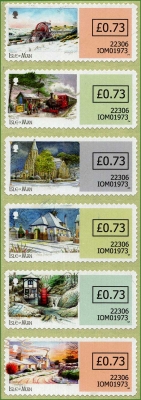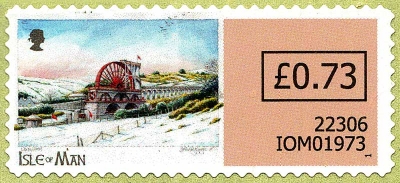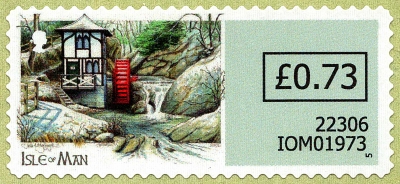-
Christmas. Manx Winter in Art of Julia Ashby Smyth. ATM issue
Isle of Man 2022.11.22
In issue: Stamp(s): 6
Printing: offset, on self-adhesive paper
Issued in: issued in panes of four vertical se-tenant strips
-
Number by catalogue: Michel: AT66I Yvert: D65 Gibbons: FSM65
Perforation type: 10x10 ½
Subject:
The required and selected denomination of the stamp was imprinted on the stamp by a stamp machine.
Apart from the different size of the stamps, they otherwise completely repeat the themes of the main series (see the previous issue of the Isle of Man).
Laxey's Wheel*.
Additional:
The Laxey Wheel (also known as Lady Isabella) is a large waterwheel built in the village of Laxey in the Isle of Man. Designed by Robert Casement, it is 72 feet 6 inches (22.10 m) in diameter and 6 feet (1.83 m) wide. It revolves at about 3 rpm.
It was built in 1854 to pump water from the mineshafts and named "Lady Isabella" after the wife of Lieutenant Governor Hope who was the island's governor at that time.
The Laxey Wheel has been claimed to be the largest working waterwheel in the world. The wheel was used to pump water from the Glen Mooar part of the ‘Great Laxey Mines’ industrial complex.
The 150th anniversary of the Lady Isabella was celebrated by the people of Laxey with a grand Fayre on Saturday 24 September 2004. It is currently maintained by Manx National Heritage as part of the Great Laxey Wheel & Mine's Trail.
The Wheel features today on the reverse side of the £20 notes issued by the Isle of Man Government.
The wheel is water-powered since the Isle of Man does not have a supply of coal but does have an abundance of water.
Water from the surrounding area, including the local river, is collected in a cistern which is above the level of the top of the wheel. A closed pipe connects the cistern to the top of the wheel; thus the water flows up the tower without problem. The water falls from the pipe into the buckets (formed from wooden slats on the circumference) and makes the wheel rotate in what is described as the 'reverse' direction. The crank has a throw of 4 feet (1.22 m) and connects to a counterweight and to a very long rod. This rod runs along the rod viaduct to the pumping shaft where the 8 feet (2.44 m) stroke is converted by T-rockers into a pumping action.
Most of the wheel and rod is made of wood; however, key mechanical parts are metal to provide tension and bearing surfaces. The rod has attached wheels at intervals to permit the stroke's motion with minimal friction.
Size (of sheet, booklet) mm: 55x25
-
Number by catalogue: Michel: AT70I Yvert: D69 Gibbons: FSM69
Perforation type: 10x10 ½
Additional:
The Groudle Glen waterwheel, affectionately known as "Little Isabella," is a Victorian waterwheel located in Groudle Glen on the Isle of Man. It was originally built around 1896 to pump water to the Groudle Hotel and provide power for the fairy lights that illuminated the glen. The wheel was recently restored to working order by mining engineering firm MMD, commemorating the company's founders.
Size (of sheet, booklet) mm: 55x25





